Thecanvas depicts the Madonna with the Child in her lap and is stylisticallyattributable to a painter active in the second half of the seventeenth century.The author is inspired by the famous iconographic prototype elaborated inseveral versions by Sir Anthony van Dyck (Antwerp, 22 March 1599 - London, 9December 1641) during his stay in Italy, between 1621 and 1625, recorded in hisItalian notebook.Thenumerous versions that the important Flemish painter produced testify to thesuccess of this composition with the noble patrons who evidently asked himseveral times to produce a new version of the subject.Thedramatic image, full of pathos, of the Virgin and the swirling drapery of theclothes and the blue mantle that surround her fully express the typicallybaroque taste of the artist, influenced, after his stay in Italy, by somepainters such as Titian. Among his sources of Italian inspiration should alsobe mentioned the Emilian classicism of Guido Reni: in his prototypes in factVan Dyck turns Mary’s gaze to heaven, in an attitude that suffers in the waysof the representation of the Mater Dolorosa and the Mourners disclosed by theReni. The strong presence of the figures also recalls examples of the greatItalian Renaissance, such as Bellini’s Madonnas, even if the volumes of thebodies here are exquisitely baroque. Particular attention is given to thecontrast between the intense tones of the Virgin’s clothes and the darkbackground from which an imposing column is barely visible.Inthese works, to the ecstatic and celestial contemplation of the Virgin, VanDyck contrasts the serene and nonchalant gaze of the Child who, in a completelyrealistic way, seems unaware of the destiny reserved for him, looking outsidethe canvas. Thesuccess of the composition is undoubtedly due to the high level of quality,distinguished by the perfect fusion of elegance, magniloquence and descriptiveforce. Theauthor of the painting is inspired by one of the many engravings that wereproduced by Van Dyck’s paintings. Among these, that of Paulus Pontius(1603-1658), is the closest. The image of the Madonna with Child in ourpainting, in fact, appears in contrast to those of the Flemish painter. This isbecause the author evidently had the opportunity to know a print of theengraving that appears specular because of the technique itself. In turn,Paulus Pontius' engraving was also successful among engravers, as Petrus Clouet(1629-1670) reasserted it, returning to show the image, again in counterpart,no longer mirror van Dyck’s work.Theauthor of our painting has given the Madonna and Child, standing, a characterstrongly linked to the classicism of Guido Reni and the very lively and brightcolor palette. The browns of van Dyck’s backgrounds, in this work are clear,where the classical column is replaced by the trunk of a tree with leafyfronds, as well as the landscape described in the background, with green woods,a blue sky marked by some fluffy cloud, in shades of grey. The bodies of theVirgin and Child, as well as the draperies, are bathed in an intense light,almost metaphysical, that illuminates the pure skin and the folds of thefabrics.Manypainters tried to reproduce this iconographic prototype, evidently sought afterby noble and bourgeois collectors who commissioned copies and similar versions.
Weapologize for any translation errors from Italian. Please click here to havethe expertise of the painting, in Italian.


















































 Le Magazine de PROANTIC
Le Magazine de PROANTIC TRÉSORS Magazine
TRÉSORS Magazine Rivista Artiquariato
Rivista Artiquariato